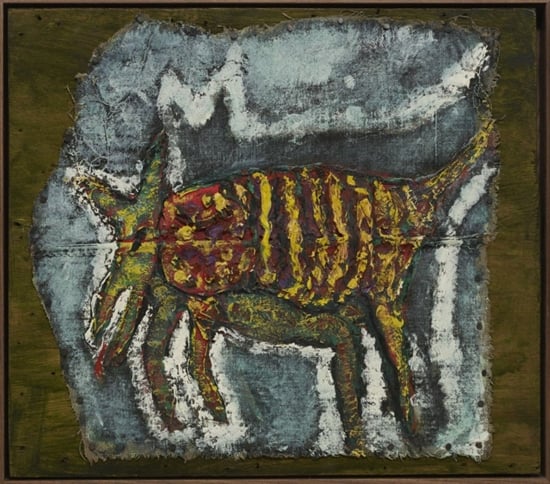
The Skinny is a series that explores artworks of note currently offered on artnet Auctions. Here, we take a look at three works in the “Post-War and Contemporary Art” sale—by Andy Warhol, Sam Francis, and Peter Doig—that are particularly interesting either for their timeliness or other reasons. Also in the sale are works by Marlene Dumas, Richard Prince, and Francois Morellet.
Who: Peter Doig
What: Moonlit Armadillo (1986) (pictured above), an oil-on-denim work mounted to wood panel that is estimated to sell for $100,000-$150,000.
Why: Because this is an authentic early work by Peter Doig. ‘So what?’ you say. Well, it matters here because recently, a former corrections officer, Robert Fletcher, claimed in a lawsuit that he owns a desert landscape that was allegedly painted by Doig in 1975 while serving time as an inmate at the Thunder Bay Correctional Center, in Ontario. Doig firmly disputes that he painted that painting in the case, which is set to go to trial.
Who: Andy Warhol
What: Vote McGovern (1972), with an estimate of $17,000-$22,000. Warhol’s crazy scary portrait of Richard Nixon with demonic eyes and green-blue skin was was published in an edition of 250 by Gemini G.E.L. in Los Angeles to raise funds for the George McGovern campaign for President. According to the artnet Price Database, the record for one of these prints is $48,931, set at Sotheby’s London in September 2007.
Why: Inspired by the Warhol work, artist Deborah Kass has just created her own version of this work, but with a portrait of Donald Trump as the evil-eyed subject, and in support of Hillary Clinton’s presidential campaign.
Who: Sam Francis
What: Untitled (SFMP-23) (1983), a mixed media work on wood estimated to sell for $100,000-$120,000.
Why: This work is more sculptural than work we’ve come to associate with Sam Francis, who was known primarily as a painter and print-maker. For his monotypes, Francis elaborately assembled his subjects using mainly a wooden board as the underlying structure and layering it with found and painted scraps of wood, whimsical shapes, clumps of dry pigment and drizzled paint. Francis called these constructions “prototypes.” Though each prototype was used only once, to create a single monotype, the prototype lived on as an artwork itself long after Francis passed. Each prototype was its own experiment pushing the boundaries of traditional printmaking, not just in the materials used, but with ever increasing scale. At 82.8 by 32.2 by 0.2 inches, it is one of his larger works.
The “Post-War and Contemporary Art” auction is live through July 19, 2016.